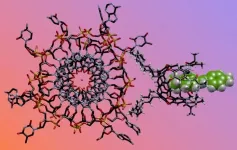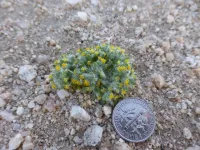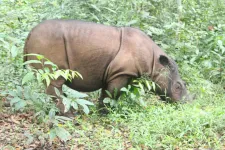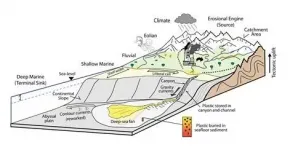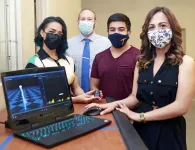(Press-News.org) Over the coming decades, our economy and society will need to dramatically reduce greenhouse gas emissions as called for in the Paris Agreement. But even a future low-carbon economy will emit some greenhouse gases, such as in the manufacture of cement, steel, in livestock and crop farming, and in the chemical and pharmaceutical industries. To meet climate targets, these emissions need to be offset. Doing so requires "negative emissions" technologies, by means of which CO2 is removed from the atmosphere and permanently stored in underground repositories.
Researchers at ETH Zurich have now calculated the potential of one of these technologies for Europe: the combination of energy extraction from biomass with the capture and storage of CO2, or bioenergy with carbon capture and storage (BECCS) as it is known. The calculations revealed that if BECCS were exploited to its full potential, it would reduce carbon emissions in Europe by 200 million tonnes per year. This represents 5 percent of European emissions in 2018 and a substantial proportion of the 7.5 billion tonnes of CO2 that Europe has to cumulatively save by 2050 to reach its climate targets. As the authors of the study also point out, however, fully exploiting the calculated potential of BECCS will be challenging in practice.
Technology ready for action
BECCS involves capturing CO2 at the point sources where it is produced from biological material. In Europe, companies in the pulp and paper industry offer the greatest potential. Other sectors with potential are waste incineration plants (where around half the waste is from biomass), combined heat and power plants that run on wood, and biogas plants that use compostable municipal waste or plant and animal byproducts of food production that are not suitable for eating. Further sources are wastewater treatment plants and livestock manure.
"The technology for capturing carbon dioxide at such point sources is ready to go," explains Marco Mazzotti, Professor at the Institute of Energy and Process Engineering and head of the study. The carbon would then have to be transported to storage locations via a network yet to be created - in pipelines, for instance. "This is a major challenge," says Lorenzo Rosa, scientist in Mazzotti's group and lead author of the study. After all, CO2 is produced unevenly across Europe. Suitable storage sites are now present only in a few places, far from the CO2 point sources, such as underneath the seabed of the North Sea. However, this challenge is solvable if such a transport network were to be built up as quickly as possible, says Rosa.
Paper industry
As the calculations of the ETH researchers revealed, the potential of BECCS varies greatly from country to country. At one extreme is Sweden, which has a strong pulp and paper industry. By using BECCS, Sweden could capture almost three times as much carbon dioxide from biomass (and thus atmospheric origin) as it emits from fossil fuels today. "If Sweden were to exploit its full BECCS potential, it could trade emission certificates and thus offset emissions in other countries," says Rosa. Finland and Estonia could reduce their CO2 emissions by half, also possible thanks to a strong pulp and paper industry. In many other European countries, the potential is lower, with emissions reductions of around 5 percent or less.
For their calculations, the ETH scientists took into account only biomass that arises as a byproduct of industry or agriculture or as waste. They deliberately factored out crops grown for the primary purpose of energy production, a practice that is more widespread in other regions of the world than in Europe. Because such farming is in direct competition with food crops, it is not considered very sustainable. "With global food demand expected to double by 2050, there is a pressing need to develop BECCS technologies that do not rely on purpose-grown bio-energy plantations," says Rosa.
Waste as raw material
In Switzerland, the BECCS potential is about 6 percent. Waste incineration plants could make up a large portion of this total. "In many other regions of Europe, by contrast, this potential lies idle, as waste is dumped unused in landfills," says ETH Professor Mazzotti.
Waste incineration plants already fulfil three important functions today: they dispose of waste; they recycle raw materials, as far as possible; and they generate district heating and electricity. "Now a fourth function is being added: as significant negative emissions facilities, waste incineration plants can help reduce the carbon footprint of our society," says Mazzotti. At present, this potential is going untapped. For the most part, no carbon dioxide is being captured yet in paper, incineration or biogas plants. In the opinion of the ETH researchers, we should start doing so as soon as possible.
INFORMATION:
Small changes in the structure of DNA have been implicated in breast cancer and other diseases, but they've been extremely difficult to detect -- until now.
Using what they describe as a "chemical nose," UC Riverside chemists are able to "smell" when bits of DNA are folded in unusual ways. Their work designing and demonstrating this system has been published in the journal Nature Chemistry.
"If a DNA sequence is folded, it could prevent the transcription of a gene linked to that particular piece of DNA," said study author and UCR chemistry professor Wenwan Zhong. "In other words, this could have a positive effect by silencing a gene with the potential to cause cancer or promote tumors."
Conversely, DNA folding ...
Talking about your bad day at work could lead to great solutions. Cold Spring Harbor Laboratory (CSHL) Associate Professor Saket Navlakha and his wife, Dr. Sejal Morjaria, an infectious disease physician at Memorial Sloan Kettering Cancer Center (MSK), found a way to predict COVID-19 severity in cancer patients. The computational tool they developed prevents unnecessary expensive testing and improves patient care.
Morjaria says, "Generally, I have good intuition for how patients will progress." However, that intuition failed her when confronted with COVID-19. She says:
"When the pandemic ...
Below please find summaries of new articles that will be published in the next issue of Annals of Internal Medicine. The summaries are not intended to substitute for the full articles as a source of information. This information is under strict embargo and by taking it into possession, media representatives are committing to the terms of the embargo not only on their own behalf, but also on behalf of the organization they represent.
1. Increased use of minimally invasive non-endoscopic tests for Barrett's esophagus screening could impact detection and prevention of esophageal cancer
Abstract: https://www.acpjournals.org/doi/10.7326/M20-7164
URL ...
Throughout the history of the West, human actions have often rushed the desert -- and their actions backfired. In the 1920s, the Colorado River Compact notoriously overallocated water still used today by several western states because water measurements were taken during a wet period.
More currently, operators of the massive Ivanpah Solar Electric Generating System in the Mojave Desert are spending around $45 million on desert tortoise mitigation after initial numbers of the endangered animals were undercounted before its construction.
A study published in the journal Ecological Applications from the University of California, Davis, and UC Santa Cruz warns against another potential desert timing mismatch amid the race against climate change and toward rapid renewable ...
The importance of pollinators to ensure successful harvests and thus global food security is widely acknowledged. However, the specific pollinators for even major crops - such as cocoa - haven't yet been identified and there remain many questions about sustainability, conservation and plantation management to enhance their populations and, thereby, pollination services. Now an international research team based in Central Sulawesi, Indonesia and led by the University of Göttingen has found that in fact ants and flies - but not ceratopogonid midges as was previously thought - appear to have a crucial role to play. In addition, they found ...
Today, the Sumatran rhinoceros (Dicerorhinus sumatrensis) is critically endangered, with fewer than 100 individuals surviving in Indonesia on the islands of Sumatra and Borneo. To ensure survival of the threatened species, accurate censusing is necessary to determine the genetic diversity of remaining populations for conservation and management plans.
A new study reported in BMC Research Notes characterized 29 novel polymorphic microsatellite markers -- repetitive DNA sequences -- that serve as a reliable censusing method for wild Sumatran rhinos. The study was a collaborative effort involving the University ...
Boulder, Colo., USA: A new focus article in the May issue of Geology summarizes research on plastic waste in marine and sedimentary environments. Authors I.A. Kane of the Univ. of Manchester and A. Fildani of the Deep Time Institute write that "Environmental pollution caused by uncontrolled human activity is occurring on a vast and unprecedented scale around the globe. Of the diverse forms of anthropogenic pollution, the release of plastic into nature, and particularly the oceans, is one of the most recent and visible effects."
The authors cite multiple studies, including one in the May issue by Guangfa Zhong and Xiaotong ...
UNIVERSITY PARK, Pa. -- As more people go online for shopping, understanding how they rely on e-commerce recommendation systems to make purchases is increasingly important. Penn State researchers now suggest that it's not just what is recommended, but how and why it's recommended, that helps to shape consumers' opinions.
In a study, the researchers investigated how people reacted to two product recommendation systems. The first system generated recommendations based on the user's earlier purchases -- often referred to as content-based recommendation systems. ...
EL PASO, Texas -- For more than a year, researchers at The University of Texas at El Paso's Stanley E. Fulton Gait Research & Movement Analysis Lab in the College of Health Sciences have been using real-time 3D animation to investigate motor impairments in children who have autism spectrum disorder (ASD). Their aim is to understand how children with autism can learn motor skills, so that they can receive effective therapies.
The results of their study, titled "Children With Autism Exhibit More Individualized Responses to Live Animation Biofeedback Than Do Typically Developing Children," were recently published in the journal of Perceptual and Motor Skills. The paper's release coincides with National Autism Awareness Month in April.
"The greatest takeaway from this study is that when teaching ...
UNIVERSITY PARK, Pa. -- Tweaking the look of a social media profile may subtly alter a person's reaction to the health messages that appear on that site, according to researchers. They add that these reactions could influence whether the users heed the advice of those messages.
In a study, the researchers found that people who gained a feeling of control when they customized an online website were more likely to perceive the health message as a threat to their freedom, lowering the chance that they will adopt the message's advice. On the other hand, when customization bolstered the users' sense of identity, they did not resent the message as much and were more willing to consider the ads' recommended behavioral changes, according to the researchers.
"In ...
